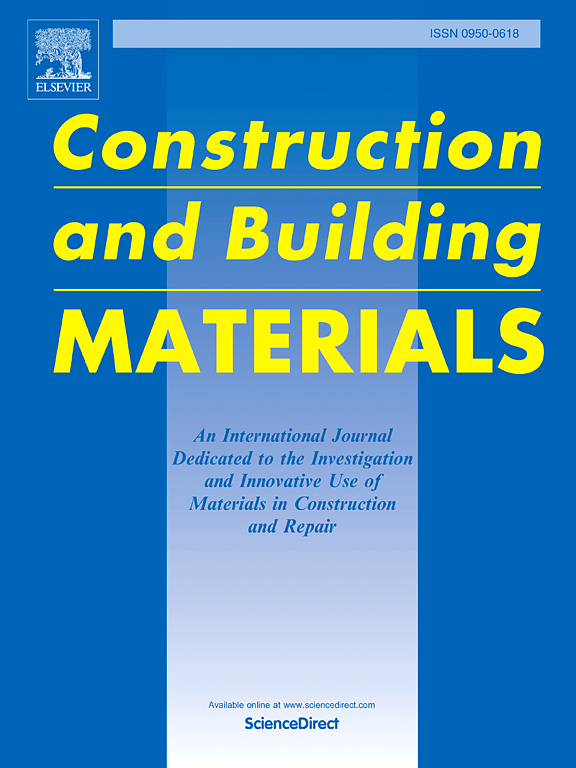用外粘接纤维增强聚合物板和近表面安装加固的胶合层合木梁的加固
IF 8
1区 工程技术
Q1 CONSTRUCTION & BUILDING TECHNOLOGY
引用次数: 0
摘要
本研究考察了使用外部粘合纤维增强聚合物(FRP)板和近表面安装(NSM)加固来提高胶合层压(胶合木)木梁的抗弯强度。分布式光纤传感器(DFOS)用于评估应变在梁的长度和深度上的分布,以及量化增强材料中的最大应变。评估了玻璃钢纤维类型(玻璃或碳)、玻璃钢层数、玻璃钢锚固细节和NSM杆类型对抗弯刚度、强度和延性的影响。用于抗弯加固的NSM材料包括钢和钛钢筋,这是一种新颖的解决方案,与FRP类似,重量轻,耐腐蚀。结果表明,在受拉侧使用外部粘结FRP片材可以促进压缩破坏,避免脆性拉伸破坏或FRP脱粘,并且与对照相比,刚度和强度分别提高了160% %和156% %。与对照相比,在压缩区添加NSM钢筋可进一步增加梁的抗弯刚度和强度,分别高达248 %和230 %。本文讨论了木材、FRP和NSM钢筋的应变分布和最大应变。本文章由计算机程序翻译,如有差异,请以英文原文为准。
Strengthening of glued-laminated timber beams using externally bonded fiber reinforced polymer sheets and near surface mounted reinforcement
This study examines the use of externally bonded fiber reinforced polymer (FRP) sheets and near-surface mounted (NSM) reinforcement to improve the flexural strength of glued-laminated (glulam) timber beams. Distributed fiber optic sensors (DFOS) were used to evaluate the distribution of strains over the length and depth of the beams as well as for quantification of the maximum strains in the reinforcing materials. The influence of FRP fiber type (glass or carbon), number of FRP layers, FRP anchorage detailing, and NSM bar type on flexural stiffness, strength, and ductility was assessed. NSM materials for flexural strengthening included both steel and titanium rebar which is a novel solution that, similar to FRP, is light-weight and corrosion-resistant. The results showed that the use of externally bonded FRP sheets on the tension side can promote a compression failure, avoiding brittle tension failure or FRP debonding and result in improvements in stiffness and strength of up to 160 % and 156 %, respectively when compared to the control. The addition of NSM reinforcement in the compression region was found to result in further increases in the beam flexural stiffness and strength by up to 248 % and 230 %, respectively when compared to the control. The distribution of strain and maximum strain achieved in the wood, FRP, and NSM reinforcement are discussed in the paper.
求助全文
通过发布文献求助,成功后即可免费获取论文全文。
去求助
来源期刊

Construction and Building Materials
工程技术-材料科学:综合
CiteScore
13.80
自引率
21.60%
发文量
3632
审稿时长
82 days
期刊介绍:
Construction and Building Materials offers an international platform for sharing innovative and original research and development in the realm of construction and building materials, along with their practical applications in new projects and repair practices. The journal publishes a diverse array of pioneering research and application papers, detailing laboratory investigations and, to a limited extent, numerical analyses or reports on full-scale projects. Multi-part papers are discouraged.
Additionally, Construction and Building Materials features comprehensive case studies and insightful review articles that contribute to new insights in the field. Our focus is on papers related to construction materials, excluding those on structural engineering, geotechnics, and unbound highway layers. Covered materials and technologies encompass cement, concrete reinforcement, bricks and mortars, additives, corrosion technology, ceramics, timber, steel, polymers, glass fibers, recycled materials, bamboo, rammed earth, non-conventional building materials, bituminous materials, and applications in railway materials.
 求助内容:
求助内容: 应助结果提醒方式:
应助结果提醒方式:


